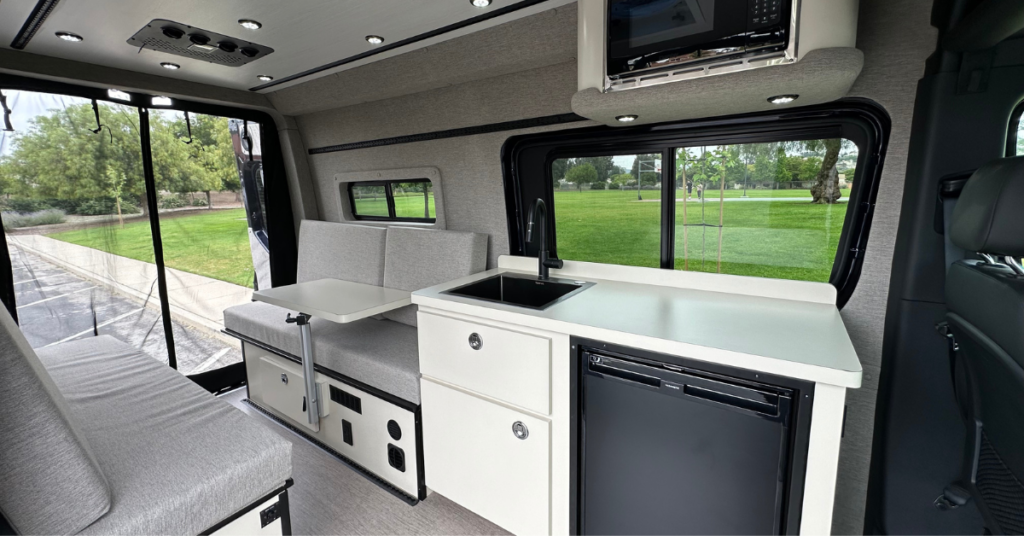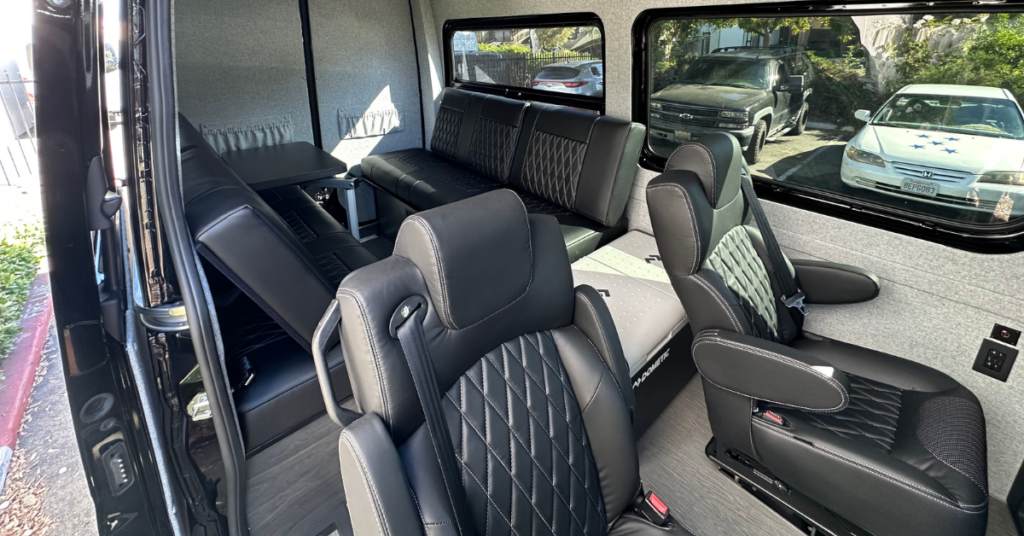Design, Comfort, and Functionality
When it comes to choosing the right seats for your van conversion, whether you’re transforming it into a campervan, gearing up for a mobile business, or kitting it out for transport, these are three key factors you’ll want to consider. With our wealth of experience from hundreds of conversions in each of these areas, we’re excited to share some insights and help guide you through these important decisions.
The Different Van Conversion Seats
There are many different types of seats available for van conversions, varying in comfort, materials, and arrangements. The ultimate goal of your van conversion will help dictate your choice of seats.
Side Facing
Side facing seats offer a unique way to integrate additional seating capacity in a multi-purpose and socially interactive way. If you think about the difference in ambiance between a bus and a limo, you’ll find a significant boost in social interactions within the limo. That’s not by accident as side facing seats promote face to face interaction in a spatially efficient design. Bringing this same basic design ethos into a campervan leads us to the incredibly popular dinette bench/bed.
The dinette layout uses two side facing and opposing benches with backrests that fill the gap to form a comfortable bed. Aside from the nearly king sized bed, the dinette layout also gives seating space for up to 8 passengers. Pair this setup with an oversized removable table and you have a functional space to sit down and work from your van for hours on end. This layout is also significantly more suitable for those who need more space to spread out for their tasks.

Think photographers who may have an editing computer set up next to their camera gear or a contractor who needs to use both a computer and look at a notepad or blueprints. Once work is finished for the day, that same space becomes your dinner and games space for friends and family.
Captain Chairs
Captains chairs bring comfort to your travel experience. These seats are the superior way to conquer road trip miles with a significant decrease in comfort fatigue. Anybody who’s been a passenger for a four-plus hour trip in a lumpy or ergonomically unfriendly seat can attest to the toll it takes on your body. I mean how is it possible to be so tired after doing nothing but sitting all day? Substitute the lumpy and hard seats of yesteryear with a quality captain’s seat with appropriately positioned arm rests, space to stretch your limbs or recline, and a nice headrest and now you have a throne to take on any trip.
Captains chairs are going to be either forward or rear facing and will need to have a 3 point seatbelt if your van is below 10,000 lbs GVWR. Quality Captains seats may also be optioned with CRS brackets which allow you to attach a car seat for safe travel with the entire family. Depending on your van’s layout, some captains’ seats can also be optioned with a side grab handle that assists getting into and out of the van’s sliding door.

Bench Seat
Bench seating has been the industry standard since before cars were ever invented. How much more simple of an arrangement can one think of? A bench seat bridges the gap between a side facing seat and a forward facing captain’s chair.
While these can be bulky and bottleneck your interior layout, they offer the most efficient solution for carrying a lot of passengers in a forward or rear facing position. This is especially important for families with multiple kids.
Being a family of 5 or more doesn’t mean you can’t travel and camp in style, it just leads to a few more elbow wars. Some manufacturers have figured out crafty ways to convert the bench seat space into a bed as well, making the bench seat a multi-functional space for your van.
Foldaway Seat (FMS Fold Away Seat)
For those who may not need a dedicated seating area at all times, queue the foldaway seat. Initially designed for multi-purpose accessibility vans that may transport passengers in wheelchairs or those without, these seats are efficiently designed to fold up against a wall when they aren’t needed.
Being a crafty campervan manufacturer, we’ve found that the functionality of the foldaway seat allows your van to convert from transport mode to camping mode in a matter of seconds. This gives you the ability to bring the kids along, but also change your shoes without the need to step outside.
Removable L-Track Seats

L-track mount seats work well when a van has very different purposes. An example of such dual purpose is a family who may run a rentals or catering business and need to load in large amounts gear for a job, but then clip in some seats for a celebratory getaway once work is finished.
Another frequent need for removable seats is a family who wants to plan for an additional passenger for only a small percentage of the time they use their van. Think of a couple who may want to take their grandkids on a fun adventure. In the event that removable L-track seating systems are a requirement for the desired functionality of your build, a variety of companies have tested offering.
These seats require a full floor system, such as a Smart Floor, or individual floor plates to be permanently installed in the van. It’s important to note that these seats will not mix and match between brands or manufacturers, so seats from VanEquipped likely won’t fit into a SmartFloor. When designing around the use of L-track based seats, it’s important to note how the seats will be utilized, where they will be stored outside of the van, and how the L-track mounts might implicate your interior build.
Choosing the Right Seating for Your Van Conversion
Primary Use of Your Van’s Seating
When setting up seating in your van, it’s important to think about your 85% use case. Seating space is a significant consideration for your van’s interior. Not giving enough thought to the functionality of the space, given your intended use and lifestyle, will certainly translate to a frustrating experience.
Will the seating space be used for passenger travel, hosting guests occasionally, creating a dedicated workspace, or accommodating your pet? Choose a seat configuration that meets your main needs while keeping laser focus on your 85% use case instead of the occasional 15% scenario that may or may not happen.
Orientation and Flexibility of Seating
It’s also important to think about the orientation of the seats. Do you want them facing forward for travel, or would you prefer them arranged sideways to make more room inside the van? Consider if swivel seats would be a good addition to create a more dynamic or relaxed environment.
If you travel with kids in car seats you’ll want to be sure that you incorporate forward facing seats with CRS brackets. Under no circumstances should you put a child with a carseat in a sideways facing seat. Also be mindful of travelers who are prone to car sickness. In the event somebody easily gets a bit queasy, they will want to ride up front or in a forward facing seat.

Understanding Pull-Tested Seats
Okay so you’ve decided on a configuration that meets your needs, now via pull testing requirements established by Federal Motor Vehicle Safety Standards (FMVSS).
What is FMVSS and why do you care?
FMVSS is the safety standard for the overall design and components that go into every new vehicle in the United States. FMVSS sets standards for vehicle manufacturers to follow in order to enforce the production of safe vehicles. There are defined testing procedures for everything from when your tail lights need to turn on to what portions of a vehicle need to be protected by airbags. The specific standards that we turn to for seating production standards specify the amount of force that a seat frame must be able to handle without failing.
The tests are a function of the weight of the seat and the passenger(s) that would be sitting in it. During testing, each seat frame must withstand a force equivalent to 1,500 lbs for each seatbelt, 150lbs per passenger, and 20 times the weight of the seat. Some seats need to handle pull focus upwards of 13,000 lbs!. This guarantees that the seat can hold an occupant securely in the unfortunate case of an accident.
It’s not just about the seat itself; how the seat is mounted to the van’s floor is equally important. The installation needs to be compatible with your specific vehicle model to ensure safety. These installation standards are part of specific safety codes, mainly the Manufacturer’s Federal Safety Standards (MFDS) codes 701 and 705, which are regulated by the National Highway Traffic Safety Administration (NHTSA) to ensure the safety and reliability of vehicular seating systems.



